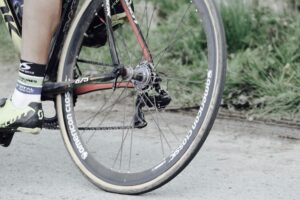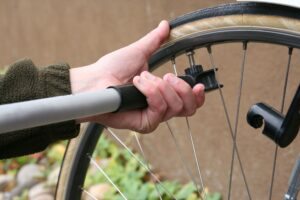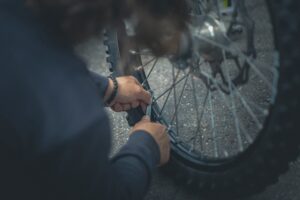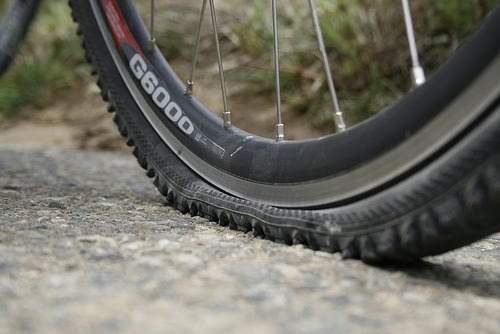Why Do Bike Tires Lose Air?
A bicycle tire without air during your ride can be the most frustrating problem and, of course, it always seems to occur at the most inconvenient time.
When you jump on your bicycle, you will expect it to be on the move already.
What is not expected, is to spend your time changing your tire on the way.
Unfortunately, you will experience a flat tire at one point in time during your cycling career, whether there is leaking air around the rim or because of diffusion through the tube.
 Brief Notes on the Tire
Brief Notes on the Tire
A wheel of a bike is made of a metal rim, spokes, and a hub in the center. A tire has some treads and it gets in contact with the road. The inner tube holds air. The innermost tubes are made of rubber that you pump air into. Therefore, sharp objects including glass, rocks, nails, and thorns can damage the innermost tubes, allowing the air to leak out.
Concerning the severity of the damage, your tire may deflate slowly or rapidly over time. Either way, you won’t be able to ride on a flat tire. This is because it can cause serious damage to the tire or its rim, which can eventually cost you a lot of money to replace or repair in the future.
Why does my tire keep going flat?
The following are the most common reasons for flat tire:
- Puncture caused by a sharp object
- Failure or damage to the valve system
- Rubbed or ripped tire
- Road hazards such as potholes
- Un-inspected damage
- Rim damage
- Slow leaks
- Tire quality
- Inner tube quality
- Damage rim tape
- Sharp edges from the rim drilling
- Pinch flat
- Inner tube pinching
The Science Behind Tire Losing Air
Rubber consists of long elastic strands of polymers.
An integral characteristic of the polymer strand is a micro pathway, which gasses can pass through. Therefore, the air in your tube will eventually escape through the micro pathways, hence, a flat tire through a process known as Diffusion.
The higher the pressure and the lower the volume, the faster the tire loses its pressure. For high-pressure tires with low volume, you will need to top up your tires every 4 to 7 days to keep it within the recommended range.
In theory, heavier gas has a difficult time passing through the rubber, which would result in your tire keeping the pressure longer. Carbon dioxide passes through rubber faster than oxygen because of its solubility. This is the reason why normal or ambient air is most preferred.
Therefore, when you are using a CO2 cartridge, it is good to replace the air more often. There is no much research done on how you can reduce the rate of diffusion in bicycle tubes. The theory says that a thicker thorn-resistant tube retains air more thus, holding pressure for a longer time. However thicker tubes add more weight to your bike and increases rolling resistance.
Things to check if you have a flat tire:

Tire wear: If your tires are weathered or low in the tread, you might end up getting frequent punctures. Check if your tire is suitable to the terrain or style of your current riding. Therefore, it is idealistic to use the correct tread and tire for your riding plan to reduce the risk of a puncture.
Tube wear: If your tubes are exposed to rough weather or have been left for some time in the tire, they can be susceptible to punctures. For example, when tires are exposed to extreme heat, they can expand leading to a deterioration of the quality of rubber. This increases the frequency of puncture occurrences.
Sharp objects:
When there is a sharp foreign object entrenched in your tire, use your fingers to run them along the inside of the tire. In this case, you feel any object that has been stuck inside and causing damage to the inner tubes.
 Valve location can cause a flat tire: The valve is on the part that can cause a flat tire. There are two types of bicycle tire air valves commonly found on tubes; road bikes commonly have a Presta valve while a mountain bike has an American valve. When your valve is faulty, your inner tube will not keep air. Therefore, it is best to replace the inner tube.
Valve location can cause a flat tire: The valve is on the part that can cause a flat tire. There are two types of bicycle tire air valves commonly found on tubes; road bikes commonly have a Presta valve while a mountain bike has an American valve. When your valve is faulty, your inner tube will not keep air. Therefore, it is best to replace the inner tube.
Self-inflicted damage: When you are changing your tubes, ensure you follow the procedure correctly so as not to damage the tube. Pinching the tube is common in mechanics or novice riders, but this will leave you with a deflated tire.
Using the right tools when changing the tube more so, tire levers to avoid tire pinching. You can also evade this problem is to inflate the tube slightly before installation to ensure that the tube is tucked inside the tire skillfully with no bends or twists.
Then, replace the edges of the tire inside the rim. Slightly, push the valve back to the tire and fill the tire with air to allow it to sit correctly and evenly without bulges. This prevents punctures.
Blowout and tire pressure: Ensure that the pressure you are inflating into a tube is the correct amount as printed on the side of the tire. It is important to know how much air your bicycle tire needs. It is normally indicated on the tire by the manufacturer.
Increased inflation will cause punctures and blowouts. When pressure is below the recommended, it can roll the tire off the rim or cause pinch flat. This can make your work difficult while riding and may lead to poor braking control.
Tire and tube quality: During the purchase of tires and tubes, ensure to get a reputable brand. A cheaper tube saves you money in the short run. However, you will eventually make up to the cost when you continually have to purchase replacements. Therefore, to avoid all that, go for reliable and well-known tires and tube brands.
How to fix your flat tire
The following are steps on how to fix your deflated tire:
- Stop riding – It is good to stop riding your bike whenever you notice your tire is flat. This will lead to your wheel rims being damage.
- Empty the tube – If there is any air left in the tube, it is advisable to release it by pressing on the valve.
- Remove the wheel – Take the wheel off by turning your bike upside down. If it is not quick to release remove the nuts with a 15 mm crescent wrench or box wrench. Besides, you may have to use your brakes to let the wheel move through the brake pads.
- Remove the tire – Using a plastic tire, move the tire lip over the rim on one side of the wheel. Let the lever slide towards the left to pull the lip around the tire. Thicker tires are easier to get on and off.
- Take the tube out of the tire – Take the tube off and take a moment to check for any thorn or glass that might have caused the puncture, because it might still be in the tire. When you remove the tube, take note of its positioning by making a mark on the tire where the valve lines up.
- Super inflate the tire – Now since the tube is out, pump it up and try to locate the leak out of the hole.
- Patch or replace – After identifying the problem, now you can replace a patch or the whole tube. If the valve is torn or the hole is big, it is good to replace the tube.
Preventive Measures
When you have repaired your puncture, it is good to put on some preventive measures. This will help to minimize your chances of a puncture during your ride.
The following measures will help you to minimize the chances of re-puncturing your inner tube:
- Tire liners are good at adding extra protection to the inner tube. They also protect the inner tube from sharp objects.
- Going with the width of your tire, you may need to match the inner tube size to ensure there is adequate tube protection. For example, when you buy a 25mm wide tire and use a 23 mm inner tube, the inner tube will spread too thin raising your chances of a puncture.
- Be cautious of the race inner tube because they are lighter but they do not give the same protection as in the tube made of thicker butyl rubber.
- Be keen on where you cycle, the main traffic lanes are normally free of glass or other things that might cause a flat. Cyclists love to cycle close to the shoulder where glasses or dangerous objects usually pile up.
- Avoid manholes and potholes when possible and pay attention to what is ahead of you. When you cycle in a group or with your friends, ensure the riders in front notify other cyclists of any hazards on the way.
- When you choose a good quality tire, it helps prevent inner tube punctures.
Conclusion
It is important to get well prepared by first identifying the reason why your tire is flat. Secondly, have the necessary tools and knowledge to do a tire change. If you are planning to save time and money, you should learn to change your inner tube. It is also good when you ensure there is plenty of spare inner tubes in cases of emergencies or locate a bike store with a reasonable distance in case you need repairs.

